Structural and Tribological Characterization of Carbon and Glass Fabrics Reinforced Epoxy for Bushing Applications Safety
Abstract
1. Introduction
2. Materials and Methods
3. Results
3.1. Structural and Tribological Characterization for Glass Fiber Composite Material
Tribological Analysis of the Glass Fiber Composite Material
3.2. Structural and Tribological Charactrizationof CarbonFiber Composite Materials
Tribological Analysis of the Carbon Fiber Composite Material
4. Discussion
5. Conclusions
Author Contributions
Funding
Data Availability Statement
Acknowledgments
Conflicts of Interest
References
- Si, Z.; Liu, F.; Pan, J.; Dong, H. Research on Impact Resistance of Reinforced Concrete Beams Strengthened with Carbon Fiber Reinforced Polymer Grid and Engineered Cementitious Composites. Polymers 2022, 14, 1951. [Google Scholar] [CrossRef] [PubMed]
- Alrshoudi, F.; Samad, U.A.; Alothman, O.Y. Evaluation of the Effect of Recycled Polypropylene as Fine Aggregate Replacement on the Strength Performance and Chloride Penetration of Mortars. Polymers 2022, 14, 2806. [Google Scholar] [CrossRef] [PubMed]
- Joyklad, P.; Yooprasertchai, E.; Wiwatrojanagul, P.; Chaiyasarn, K.; Ali, N.; Hussain, Q. Use of Natural and Synthetic Fiber-Reinforced Composites for Punching Shear of Flat Slabs: A Comparative Study. Polymers 2022, 14, 719. [Google Scholar] [CrossRef] [PubMed]
- Murcia, D.H.; Çomak, B.; Soliman, E.; Taha, M.M.R. Flexural Behavior of a Novel Textile-Reinforced Polymer Concrete. Polymers 2022, 14, 176. [Google Scholar] [CrossRef] [PubMed]
- Sirisonthi, A.; Julphunthong, P.; Joyklad, P.; Suparp, S.; Ali, N.; Javid, M.A.; Chaiyasarn, K.; Hussain, Q. Structural Behavior of Large-Scale Hollow Section RC Beams and Strength Enhancement Using Carbon Fiber Reinforced Polymer (CFRP) Composites. Polymers 2021, 14, 158. [Google Scholar] [CrossRef] [PubMed]
- Adosi, B.; Mirjalili, S.A.; Adresi, M.; Tulliani, J.M.; Antonaci, P. Experimental Evaluation of Tensile Performance of Aluminate Cement Composite Reinforced with Weft Knitted Fabrics as a Function of Curing Temperature. Polymers 2021, 13, 4385. [Google Scholar] [CrossRef]
- Abousnina, R.; Premasiri, S.; Anise, V.; Lokuge, W.; Vimonsatit, V.; Ferdous, W.; Alajarmeh, O. Mechanical Properties of Macro Polypropylene Fibre-Reinforced Concrete. Polymers 2021, 13, 4112. [Google Scholar] [CrossRef]
- Ferdous, W.; Manalo, A.; Salih, C.; Yu, P.; Abousnina, R.; Heyer, T.; Schubel, P. Behaviour of polymer filled composites for novel polymer railway sleepers. Polymers 2021, 13, 1324. [Google Scholar] [CrossRef]
- Dong, S.; Li, C.; Xian, G. Environmental impacts of glass-and carbon-fiber-reinforced polymer bar-reinforced seawater and sea sand concrete beams used in marine environments: An LCA case study. Polymers 2021, 13, 154. [Google Scholar] [CrossRef]
- Chai, C.; Cheng, Y.; Zhang, Y.; Zhu, B.; Liu, H. Mechanical properties of crumb rubber and basalt fiber composite modified porous asphalt concrete with steel slag as aggregate. Polymers 2020, 12, 2552. [Google Scholar] [CrossRef]
- Panigrahi, S.K. Structural design of single lap joints with delaminated FRP composite adherends. Compos. Part B Eng. 2013, 51, 112–120. [Google Scholar] [CrossRef]
- Park, Y.B.; Song, M.G.; Kim, J.J.; Kweon, J.H.; Choi, J.H. Strength of carbon/epoxy composite single-lap bonded joints in various environmental conditions. Compos. Struct. 2010, 92, 2173–2180. [Google Scholar] [CrossRef]
- Ata, M.H.; Abu-Okail, M.; Essa, G.M.; Mahmoud, T.S.; Hassab-Allah, I. Failure mode and failure load of adhesively bonded compositejoints made by glass fiber-reinforced polymer. J. Fail. Anal. Prev. 2019, 19, 950–957. [Google Scholar] [CrossRef]
- Abu-Okail, M.; Nafea, M.; Ghanem, M.A.; El-Sheikh, M.N.; El-Nikhaily, A.E.; Abu-Oqail, A. Damage mechanism evaluation of polymermatrix composite reinforced with glass fiber via modified Arcan test specimens. J. Fail. Anal. Prev. 2021, 21, 451–461. [Google Scholar] [CrossRef]
- Abu-Okail, M.; Alsaleh, N.A.; Farouk, W.M.; Elsheikh, A.; Abu-Oqail, A.; Abdelraouf, Y.A.; Ghafaar, M.A. Effect of dispersion of alumina nanoparticles and graphene nanoplatelets on microstructural and mechanical characteristics of hybrid carbon/glass fibers reinforced polymer composite. J. Mater. Res. Technol. 2021, 14, 2624–2637. [Google Scholar] [CrossRef]
- Bafakeeh, O.T.; Shewakh, W.M.; Abu-Oqail, A.; Abd-Elaziem, W.; Abdel Ghafaar, M.; Abu-Okail, M. Synthesis and Characterization of Hybrid Fiber-Reinforced Polymer by Adding Ceramic Nanoparticles for Aeronautical Structural Applications. Polymers 2021, 13, 4116. [Google Scholar] [CrossRef] [PubMed]
- Al-Shelkamy, S.A.; El-Hossary, F.M.; Vega-Carrillo, H.R.; Mosa, E.S.; Daha, M.A.; Ghafaar, M.A.; Abd El-Moula, A.A. Improving the properties of commercial steel alloys in the industrial/nuclear field by RF plasma carbonitriding. Appl. Radiat. Isot. 2023, 193, 110619. [Google Scholar] [CrossRef] [PubMed]
- Al-Shelkamy, S.A.; Mosa, E.S.; Mahdy, A.A.; Elkady, O. (2022, October). Studies on heavy tungsten materials manufactured by Powder technology for Nuclear applications. In Proceedings of the XXII International Symposium on Solid State Dosimetry, Zacatecas, Mexico, 19–23 September 2022; Volume 1. [Google Scholar]
- Al-Shelkamy, S.A.; Hashish, H.M.; Salama, E. Radiation Attenuation, Structural, Mechanical and Lubricant Wear Analysis Against 5% wt NaCl of Heat Treated Stainless Steel Grades. In Proceedings of the ISSSD 2021: 21 International Symposium on Solid State Dosimetry, Ciudad de Mexico, Mexico, 27 September–1 October 2021; Sociedad Mexicana de Irradia: Ciudad de Mexico, Mexico, 2021. [Google Scholar]
- De Freitas Dam, R.S.; Affonso, R.R.W.; Salgado, W.L.; Schirru, R.; Salgado, C.M. Application of Radioactive Particle Tracking Location Algorithms: A Comparative Study. In Proceedings of the XXII International Symposium on Solid State Dosimetry, Zacatecas, Mexico, 19–23 September 2022; Sociedad Mexicana de Irradiacion y Dosimetria: Mexico City, Mexico, 2022; Volume 1. [Google Scholar]
- El-Kameesy, S.U.; El-Hossary, F.M.; Eissa, M.M.; Abd El-Moula, A.A.; Al-Shelkamy, S.A. Enhancing the capability of plasma treated austenite stainless steels as thermal reactor materials. Mater. Res. Express 2019, 6, 126589. [Google Scholar] [CrossRef]
- El-Hossary, F.M.; El-Kameesy, S.U.; Eissa, M.M.; Abd El-Moula, A.A.; Al-Shelkamy, S.A. Influence of Rf plasma carbonitriding on AISI304L, SSMn6Ni and SSMn10Ni for nuclear applications. Mater. Res. Express 2019, 6, 096596. [Google Scholar] [CrossRef]
- Salih, C.; Manalo, A.; Ferdous, W.; Abousnina, R.; Yu, P.; Heyer, T.; Schubel, P. Novel bending test method for polymer railway sleeper materials. Polymers 2021, 13, 1359. [Google Scholar] [CrossRef]
- Abousnina, R.; Alsalmi, H.I.; Manalo, A.; Allister, R.L.; Alajarmeh, O.; Ferdous, W.; Jlassi, K. Effect of short fibres in the mechanical properties of geopolymer mortar containing oil-contaminated sand. Polymers 2021, 13, 3008. [Google Scholar] [CrossRef]
- Krivoshapkin, P.V.; Mishakov, I.V.; Vedyagin, A.A.; Bauman, Y.I.; Krivoshapkina, E.F. Synthesis and characterization of carbon/ceramic composite materials for environmental applications. Compos. Commun. 2017, 6, 17–19. [Google Scholar] [CrossRef]
- Parameswaranpillai, J.; Jacob, J.; Vijayan, S.; Dominic, C.M.; Muthukumar, C.; Thiagamani, S.M.K.; Krishnasamy, S.; Salim, N.V.; Hameed, N. Tribological Behavior of Natural Fiber-Reinforced Polymeric Composites. In Tribology of Polymers, Polymer Composites, and Polymer Nanocomposites; Elsevier: Amsterdam, The Netherlands, 2023; pp. 153–171. [Google Scholar] [CrossRef]
- Katiyar, J.K.; Jena, H. The Role of Synthetic Fibers in the Tribological Behavior of Polymeric Materials. In Tribology of Polymers, Polymer Composites, and Polymer Nanocomposites; Elsevier: Amsterdam, The Netherlands, 2023; pp. 173–194. [Google Scholar] [CrossRef]
- Demiroglu, S.; Singaravelu, V.; Seydibeyoğlu, M.Ö.; Misra, M.; Mohanty, A.K. The Use of Nanotechnology for Fibre-Reinforced Polymer Composites. In Fiber Technology for Fiber-Reinforced Composites; Woodhead Publishing: Sawston, UK, 2017; pp. 277–297. [Google Scholar] [CrossRef]
- Seong, M.S.; Kim, T.H.; Nguyen, K.H.; Kweon, J.H.; Choi, J.H. A parametric study on the failure of bonded single-lap joints of carbon composite and aluminum. Compos. Struct. 2008, 86, 135–145. [Google Scholar] [CrossRef]
- El-Kameesy, S.U.; El-Hossary, F.M.; Eissa, M.M.; Abd El-Moula, A.A.; Al-Shelkamy, S.A.; Saeed, A. Radiation Shielding, Mechanical and Tribological Properties of Treated AISI304L using H2/N2 rf Plasma. J. Phys. Conf. Ser. 2019, 1253, 012034. [Google Scholar] [CrossRef]
- Saeed, A.; Eissa, M.; El-Hossary, F.; EL-Kameesy, S.; Elmoula, A. Mechanical and gamma ray attenuation properties of N316L steel treated by rf plasma as a nuclear material. Arab. J. Nucl. Sci. Appl. 2019, 52, 7–12. [Google Scholar] [CrossRef]
- Abu–Okail, M.; Shewakh, W.M.; Brisha, A.M.; Abdelraouf, Y.A.; Abu-Oqail, A. Effect of GNPs content at various compaction pressures and sintering temperatures on the mechanical and electrical properties of hybrid Cu/Al2O3/xGNPs nanocomposites synthesized by high energy ball milling. Ceram. Int. 2020, 46, 18037–18045. [Google Scholar] [CrossRef]
- Hamrock, B.J.; Schmid, S.R.; Jacobson, B.O. Fundamentals of Fluid Film Lubrication; CRC Press: Boca Raton, FL, USA, 2004. [Google Scholar] [CrossRef]
- El-Hossary, F.M.; El-kameesy, S.U.; Eissa, M.M.; Abd Elmula, A.Z.A.; Saeed, A.; Al-Shelkamy, S.A. Effect of Plasma Surface Treatment on AISI 316LStainless Steel for In-Core Applications of Nuclear Reactors. In Proceedings of the 4th International Conference on Energy Engineering, Aswan, Egypt, 26–28 December 2017. [Google Scholar]
- Singh, P.K.; Singh, A.K. An Investigation on the Effects of the Various Techniques Over the Performance and Durability of Polymer Gears. Mater. Today Proc. 2017, 4, 1606–1614. [Google Scholar] [CrossRef]
- Puchy, V.; Hvizdos, P.; Dusza, J.; Kovac, F.; Inam, F.; Reece, M.J. Wear Resistance of Al2O3–CNT Ceramic Nanocomposites at Room and High Temperatures. Ceram. Int. 2013, 39, 5821–5826. [Google Scholar] [CrossRef]
- Tunalioglu, M.S.; Agca, B.V. Wear and Service Life of 3-D Printed Polymeric Gears. Polymers 2022, 14, 2064. [Google Scholar] [CrossRef]
- Al-Shelkamy, S.A.; Hashish, H.M.A.; Salama, E. Influence of heat treatment on the mechanical and the lubricant wear characteristics of stainless-steel grades against 5 wt% NaCl as industrial shielding materials. Appl. Radiat. Isot. 2022, 188, 110361. [Google Scholar] [CrossRef]
- Al-Shelkamy, S.A.; Abu Hashish, H.M.; Mahdy, A.A. Structural and tribological properties of heat-treated stainless steels against abrasive and lubricant wear conditions. Coatings 2021, 11, 1473. [Google Scholar] [CrossRef]
- Al-Shelkamy, S.A.; El-Hossary, F. Radiofrequency plasma surface engineering method stainless steel alloy for the nuclear power plant unit. In Proceedings of the XXII International Symposium on Solid State Dosimetry, Zacatecas, Mexico, 19–23 September 2022. [Google Scholar]
- Prajapati, P.K.; Kumar, S.; Singh, K.K. Taguchi approach for comparative optimization of tribological behavior of glass fabric reinforced epoxy composite with and without graphene-nano platelets filler. Mater. Today Proc. 2023, 72, 1605–1612. [Google Scholar] [CrossRef]
- Zaghloul, M.Y.; Zaghloul, M.M.Y.; Zaghloul, M.M.Y. Influence of stress level and fibre volume fraction on fatigue performance of glass fibre-reinforced polyester composites. Polymers 2022, 14, 2662. [Google Scholar] [CrossRef] [PubMed]
- Khamaj, A.; Farouk, W.M.; Shewakh, W.M.; Abu-Oqail, A.M.I.; Wagih, A.; Abu-Okail, M. Effect of lattice structure evolution on the thermal and mechanical properties of Cu–Al2O3/GNPs nanocomposites. Ceram. Int. 2021, 47, 16511–16520. [Google Scholar] [CrossRef]
- Zhao, G.; Hussainova, I.; Antonov, M.; Wang, Q.; Wang, T. Friction and wear of fiber reinforced polyimide composites. Wear 2013, 301, 122–129. [Google Scholar] [CrossRef]
- Savaş, S.; Gurbanov, N.; Doğan, M. Effect of fiber type, fiber content, and compatibilizer on two-body abrasive wear performance of HDPE matrix composites. J. Compos. Mater. 2019, 53, 2743–2760. [Google Scholar] [CrossRef]
- He, T.; Xie, Z.; Tao, X.; Yang, K.; Jiao, J.; Huang, M.; Ma, W. Analysis of the Tribological and Dynamic Performance of the Self-Adapting Water-Lubricated Stern Bearing. Lubricants 2022, 10, 245. [Google Scholar] [CrossRef]
- Sabry, I.; El-Zathry, N.E.; Gadallah, N.; Ghafaar, M.A. Implementation of Hybrid RSM-GA Optimization Techniques in Underwater Friction Stir Welding. J. Phys. Conf. Ser. 2022, 2299, 012014. [Google Scholar] [CrossRef]
- Sabr, I.; El-Zathry, N.E.; Given, F.T.E.-B.; Ghaffar, M.A. Extended Hybrid Statistical Tools ANFIS-GA to Optimize Underwater Friction Stir Welding Process Parameters for Ultimate Tensile Strength Amelioration. In Proceedings of the 2021 3rd Novel Intelligent and Leading Emerging Sciences Conference (NILES), Giza, Egypt, 23–25 October 2021; pp. 59–62. [Google Scholar] [CrossRef]
- Sabry, I.; Allah, N.G.; Nour, M.A.; Ghafaar, M.A. Mechanical Characteristic of Al 6063 Pipe Joined by Underwater Friction Stir Welding. In Proceedings of the Fourth International Conference on Inventive Material Science Applications, Advances in Sustainability Science and Technology, Coimbatore, India, 14–15 May 2021; Bindhu, V., Tavares, R.S.J.M., Ţălu, Ş., Eds.; Springer: Singapore, 2022. [Google Scholar] [CrossRef]
- Saddik, M.S.; Elsayed, M.M.; Abdel-Rheem, A.A.; El-Mokhtar, M.A.; Mosa, E.S.; Al-Hakkani, M.F.; Khames, A.; Daha, M.A.; Abdel-Aleem, J.A. A Novel C@ Fe@ Cu Nanocomposite Loaded with Doxorubicin Tailored for the Treatment of Hepatocellular Carcinoma. Pharmaceutics 2022, 14, 1845. [Google Scholar] [CrossRef]
- Saddik, M.S.; Elsayed, M.M.; El-Mokhtar, M.A.; Sedky, H.; Abdel-Aleem, J.A.; Abu-Dief, A.M.; Al-Hakkani, M.F.; Hussein, H.L.; Al-Shelkamy, S.A.; Meligy, F.Y.; et al. Tailoring of novel azithromycin-loaded zinc oxide nanoparticles for wound healing. Pharmaceutics 2022, 14, 111. [Google Scholar] [CrossRef]
- Al-Hakkani, M.F.; Hassan, S.H.; Saddik, M.S.; El-Mokhtar, M.A.; Al-Shelkamy, S.A. Bioengineering, characterization, and biological activities of C@ Cu2O@ Cu nanocomposite based-mediated the Vicia faba seeds aqueous extract. J. Mater. Res. Technol. 2021, 14, 1998–2016. [Google Scholar] [CrossRef]






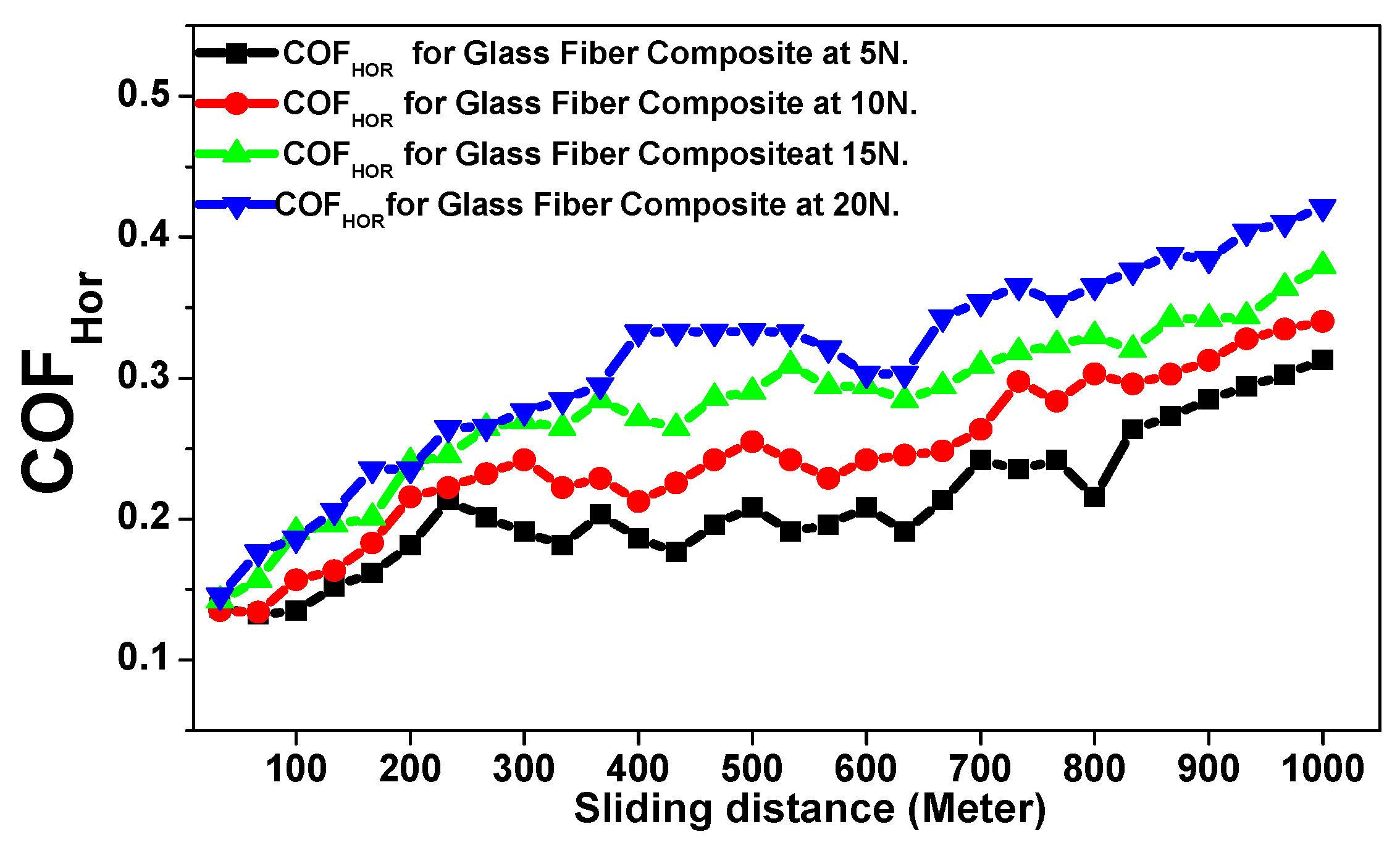
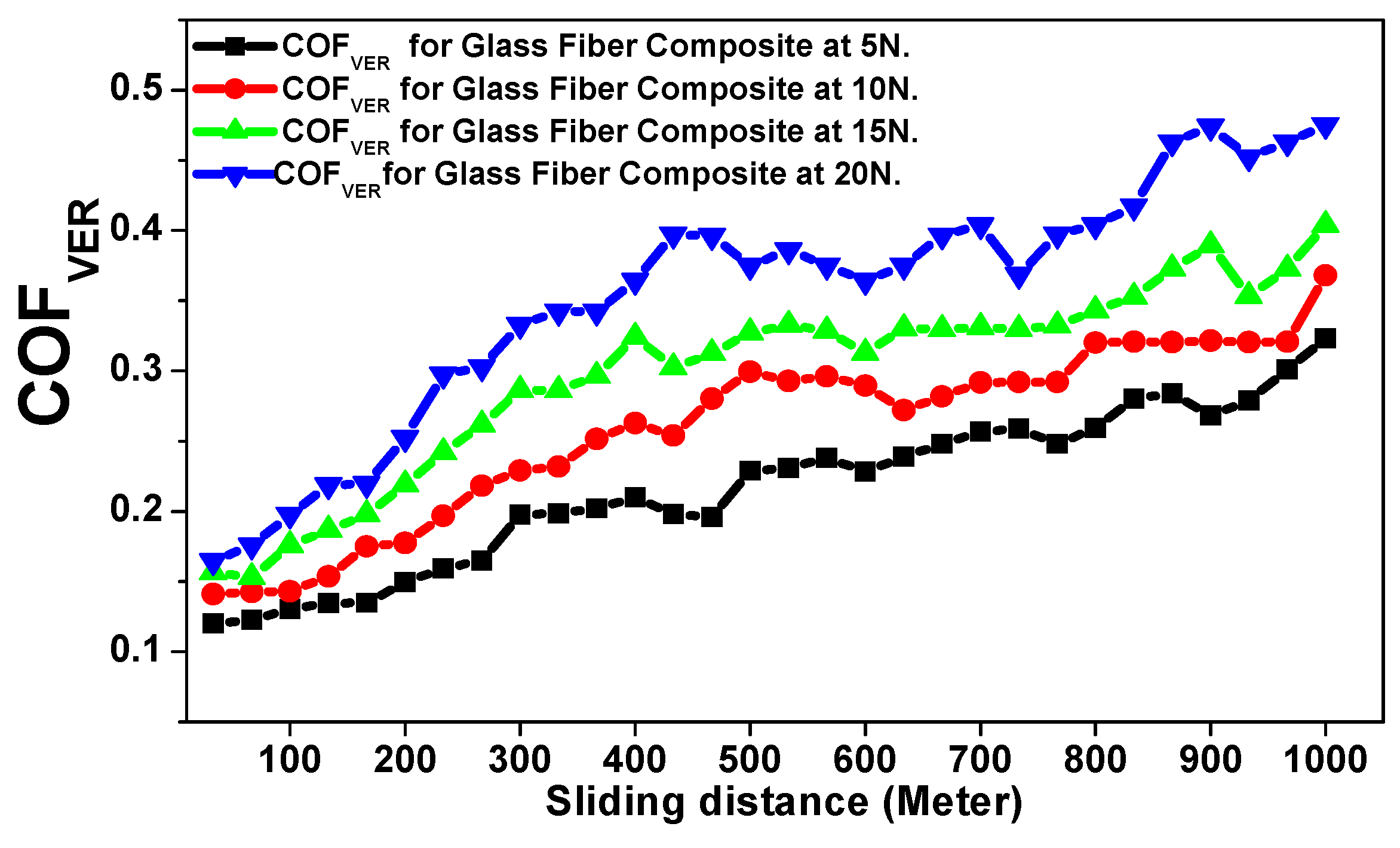



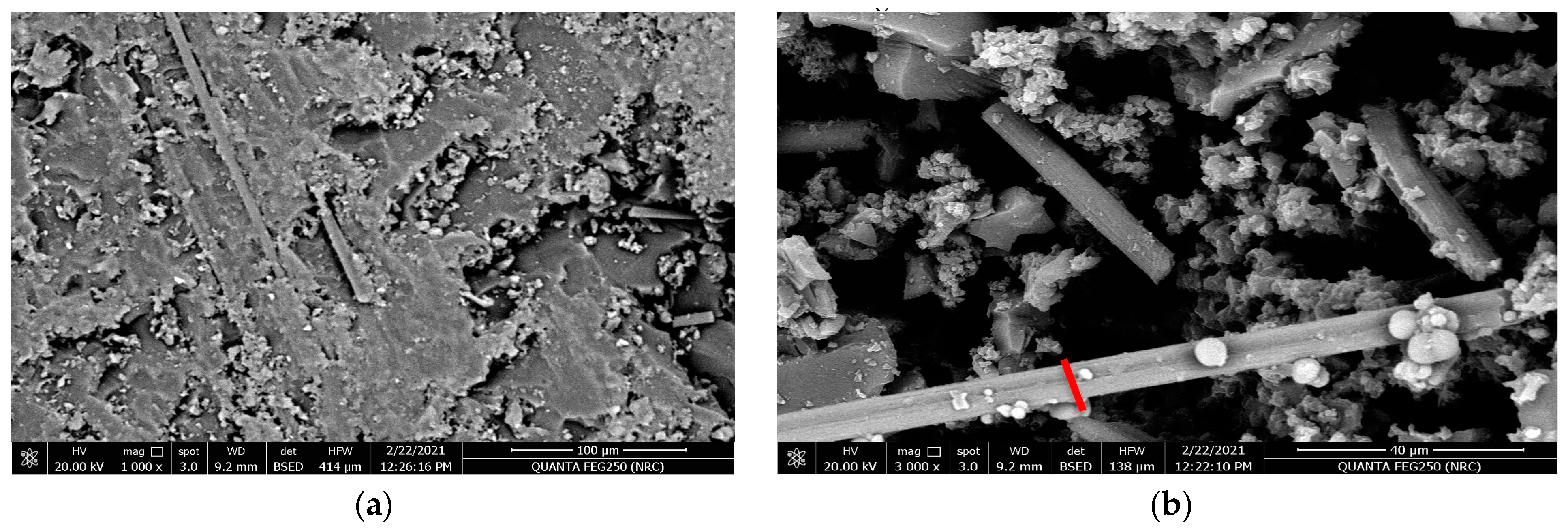
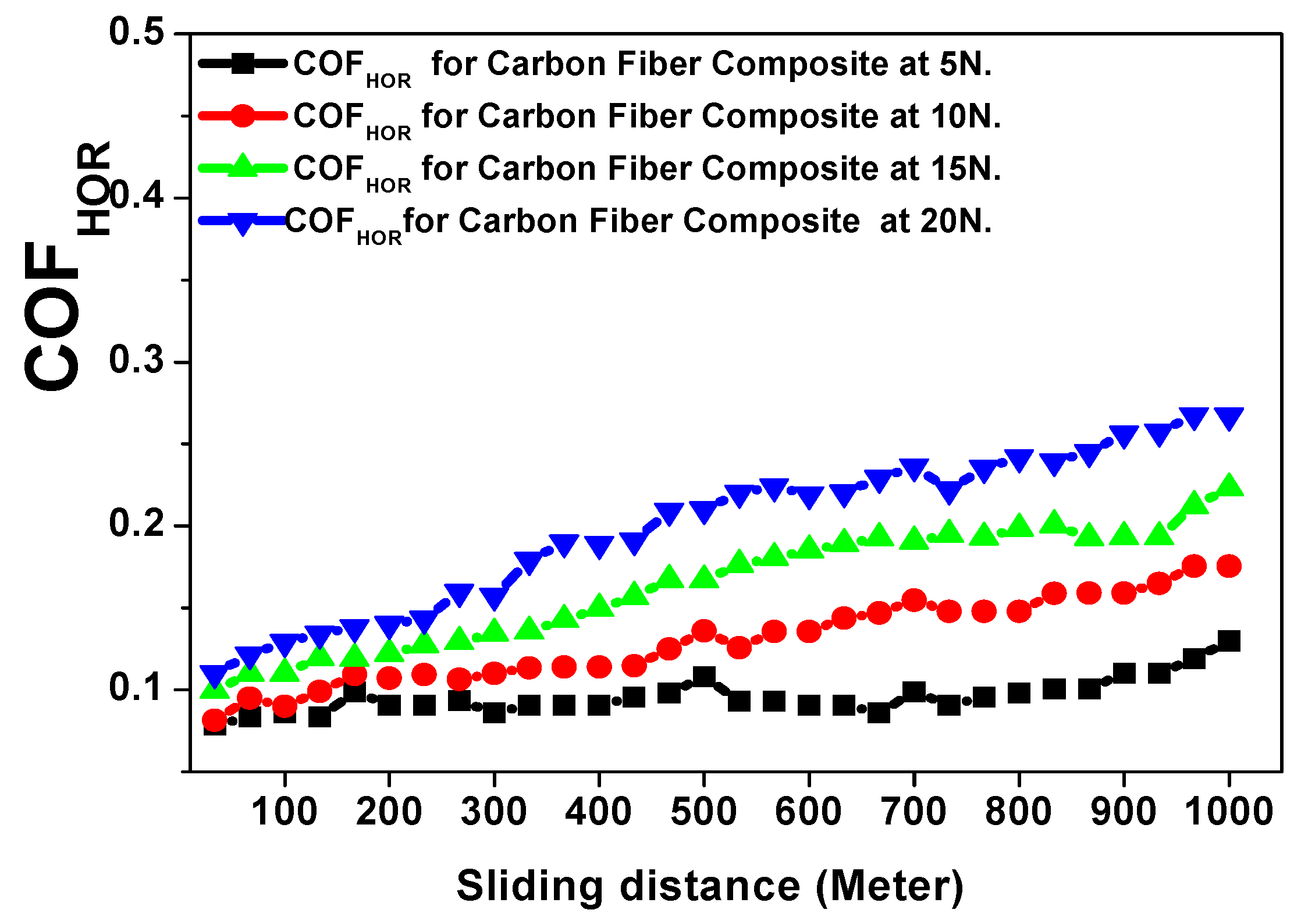
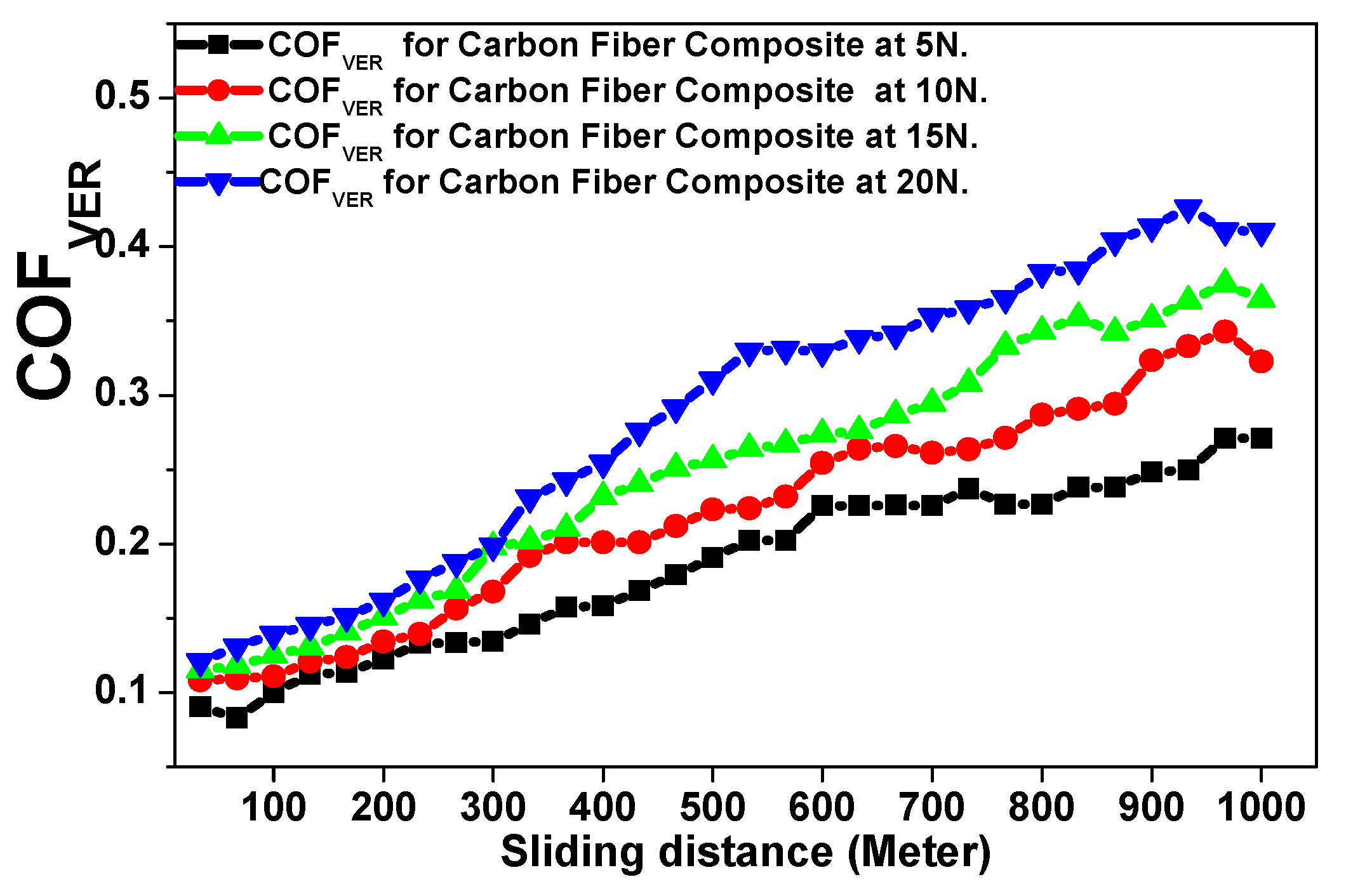
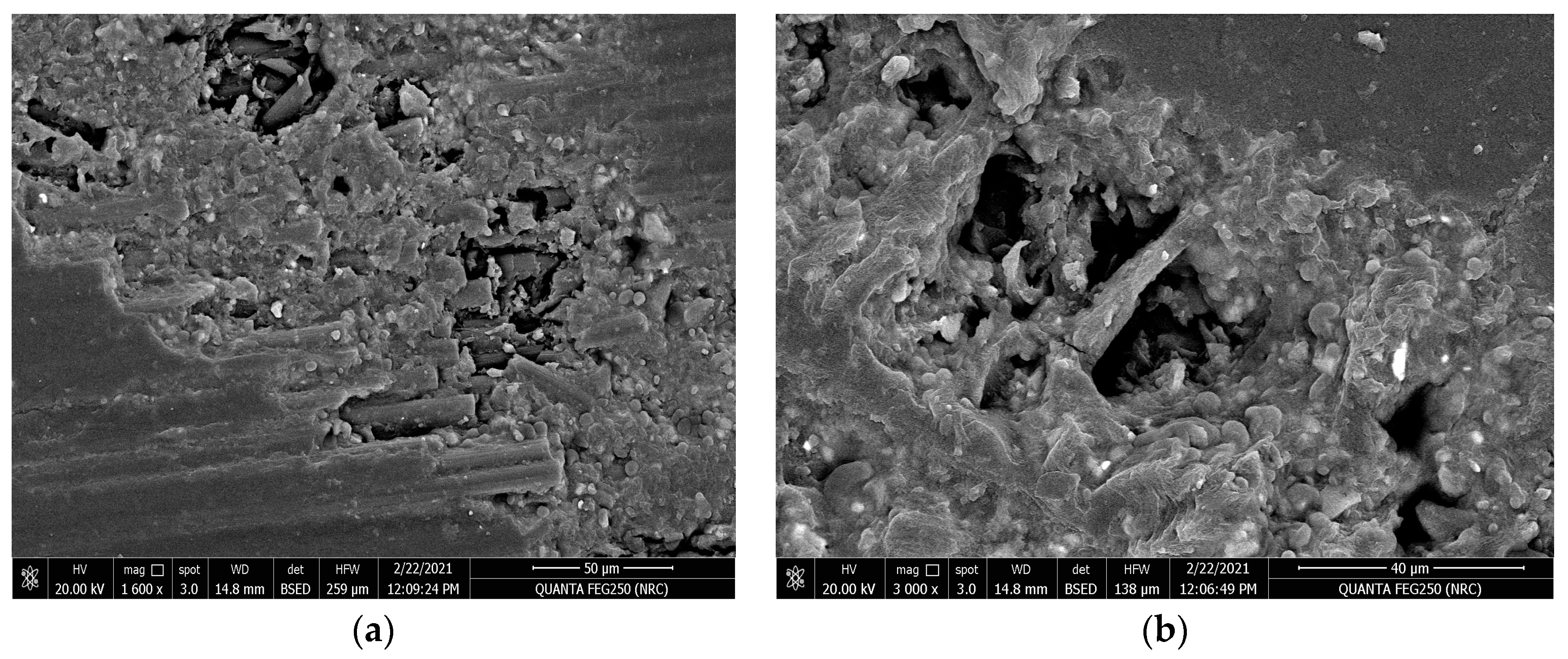
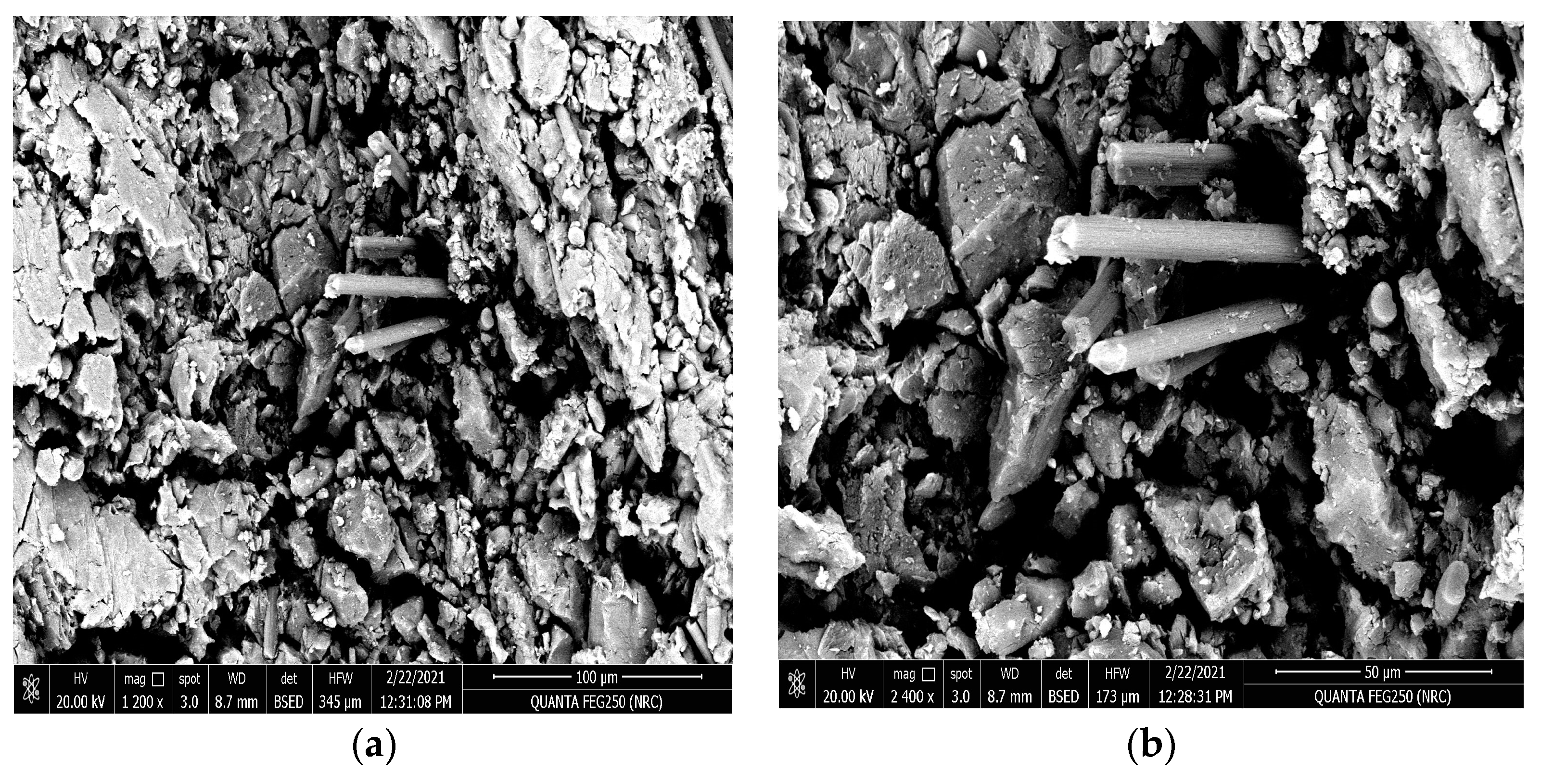
| Product | Glass Fiber | Carbon Fiber |
|---|---|---|
| Warp Raw | 2 k, multifilament continuous | 3 k, multifilament continuous |
| Filling Raw | 2 k, multifilament continuous | 3 k, multifilament continuous |
| Weave Pattern | Plain | Plain |
| Surface Density | 320 g/m2 | 200 g/m2 |
| Dressing Agents | Saline-coated/Volans-treated after heat cleaning | None |
| Material | Applied Load (N) | Friction Coefficient Mean | Specific Wear Rate (cm3/N.m) |
|---|---|---|---|
| Horizontal Glass Fiber Composite | 5 | 0.2022 ± 0.0048 | (3.7934 ± 0.0091) × 10−10 |
| 10 | 0.2419 ± 0.0055 | (5.5217 ± 0.0126) × 10−10 | |
| 15 | 0.2882 ± 0.0058 | (6.5326 ± 0.0131) × 10−10 | |
| 20 | 0.3325 ± 0.0071 | (8.3804 ± 0.0180) × 10−10 | |
| Vertical Glass Fiber Composite | 5 | 0.2120 ± 0.0056 | (5.9782 ± 0.0148) × 10−10 |
| 10 | 0.2810 ± 0.0063 | (7.500 ± 0.0169) × 10−10 | |
| 15 | 0.3258 ± 0.0068 | (8.1521 ± 0.0172) × 10−10 | |
| 20 | 0.3751 ± 0.0088 | (9.6739 ± 0.0228) × 10−10 |
| Material | Applied Load (N) | Friction Coefficient Mean | Specific Wear Rate (cm3/N.m) |
|---|---|---|---|
| Horizontal Carbon Fiber composite | 5 | 0.0931 ± 0.0010 | (1.6304 ± 0.0019) × 10−10 |
| 10 | 0.1306 ± 0.0025 | (2.9021 ± 0.0057) × 10−10 | |
| 15 | 0.1718 ± 0.0035 | (3.2717 ± 0.0067) × 10−10 | |
| 20 | 0.2145 ± 0.004 | (4.3369 ± 0.0095) × 10−10 | |
| Vertical Carbon Fiber Composite | 5 | 0.2061 ± 0.0056 | (3.6956 ± 0.0107) × 10−10 |
| 10 | 0.2810 ± 0.0072 | (4.7826 ± 0.0155) × 10−10 | |
| 15 | 0.3258 ± 0.0083 | (5.6521 ± 0.0181) × 10−10 | |
| 20 | 0.3751 ± 0.0099 | (6.5217 ± 0.0203) × 10−10 |
Disclaimer/Publisher’s Note: The statements, opinions and data contained in all publications are solely those of the individual author(s) and contributor(s) and not of MDPI and/or the editor(s). MDPI and/or the editor(s) disclaim responsibility for any injury to people or property resulting from any ideas, methods, instructions or products referred to in the content. |
© 2023 by the authors. Licensee MDPI, Basel, Switzerland. This article is an open access article distributed under the terms and conditions of the Creative Commons Attribution (CC BY) license (https://creativecommons.org/licenses/by/4.0/).
Share and Cite
Moosa, M.H.; Abu-Okail, M.; Abu-Oqail, A.; Al-Shelkamy, S.A.; Shewakh, W.M.; Ghafaar, M.A. Structural and Tribological Characterization of Carbon and Glass Fabrics Reinforced Epoxy for Bushing Applications Safety. Polymers 2023, 15, 2064. https://doi.org/10.3390/polym15092064
Moosa MH, Abu-Okail M, Abu-Oqail A, Al-Shelkamy SA, Shewakh WM, Ghafaar MA. Structural and Tribological Characterization of Carbon and Glass Fabrics Reinforced Epoxy for Bushing Applications Safety. Polymers. 2023; 15(9):2064. https://doi.org/10.3390/polym15092064
Chicago/Turabian StyleMoosa, Majed H., Mohamed Abu-Okail, Ahmed Abu-Oqail, Samah A. Al-Shelkamy, W. M. Shewakh, and M. Abdel Ghafaar. 2023. "Structural and Tribological Characterization of Carbon and Glass Fabrics Reinforced Epoxy for Bushing Applications Safety" Polymers 15, no. 9: 2064. https://doi.org/10.3390/polym15092064
APA StyleMoosa, M. H., Abu-Okail, M., Abu-Oqail, A., Al-Shelkamy, S. A., Shewakh, W. M., & Ghafaar, M. A. (2023). Structural and Tribological Characterization of Carbon and Glass Fabrics Reinforced Epoxy for Bushing Applications Safety. Polymers, 15(9), 2064. https://doi.org/10.3390/polym15092064








